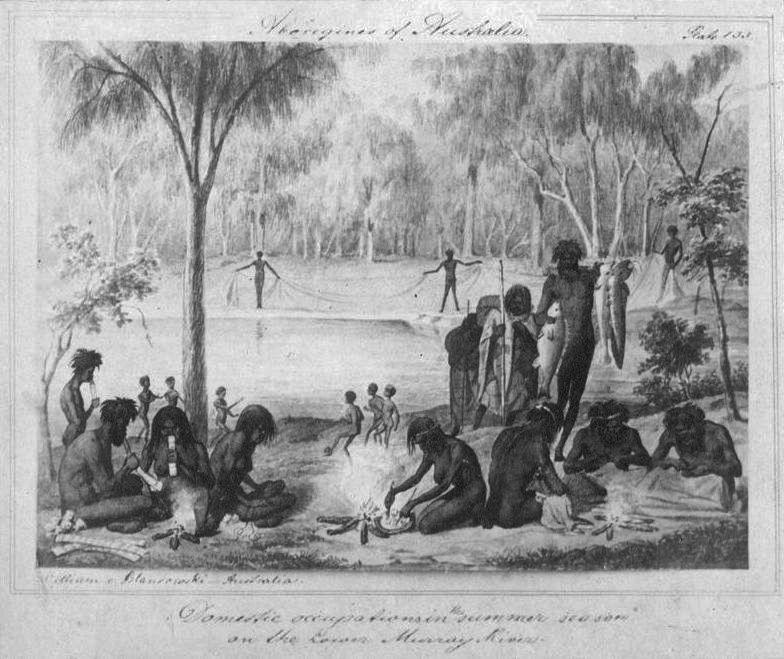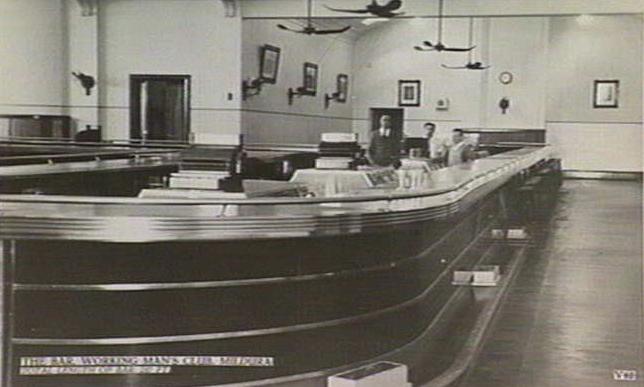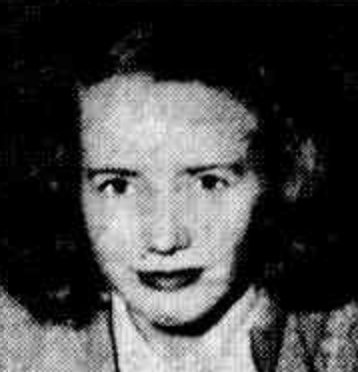|
Latjilatji
The Latjilatji, sometimes spelt Latji Latji or Latje Latje are an Indigenous Australian people of the state of Victoria, Australia. Name The ethnonym Latjilatji consists of a reduplication of the word for "no" (''latja''). Language Latjilatji is a Western Central Murray language classified as a member of the Kulinic language branch of the Pama Nyungan language family. It is closely related to Matimati and Wadiwadi. A vocabulary of the tongue, compiled by E. M. Curr from informants interviewed at Kulkyne, was published in 1887. It is critically endangered, with 10 speakers being recorded in 2004. Country The Latjilatji lands extended over some , ranging from Chalka Creek to Mildura on southern bank of Murray River, and stretching some 50 miles to its south. It encompassed Kulkyne, and ran south as far the vicinity of Murrayville and Pine Plains. Social organization The Latjilatji are divided into two moieties, the ''Kailpara'' and ''Makwara'', the former connected to ... [...More Info...] [...Related Items...] OR: [Wikipedia] [Google] [Baidu] |
Tatitati
The Dadi Dadi or Tatitati are an Australian Aboriginal people whose traditional lands are located along the southern banks of the Murray River in Victoria Australia. Language The Dadi Dadi language is a nearly extinct member of the Lower Murray languages, which form a branch of the Pama-Nyungan language family. During the 1960s and 1970s samples of the language were recorded by Luise Hercus. The language is related to Yita Yita. Most of the tribal names of this group ( Nari-Nari, Barababaraba, Latjilatji, Warkawarka, Watiwati, Wemba-Wemba) are formed by a reduplication of the word for 'no' in their respective languages, the word 'tati' bearing that sense. Country The Dadi Dadi lands, according to Norman Tindale, extended over , covering the area from Euston to above the Murrumbidgee junction. Though mainly concentrated on the southern bank of the Murray River, they also ranged as far north as Benanee. As part of the Murray–Darling basin, the area's history of human habi ... [...More Info...] [...Related Items...] OR: [Wikipedia] [Google] [Baidu] |
Latji-Latji Language
Ladji Ladji (Ledji-Ledji) is a moribund Australian Aboriginal language once widely spoken in New South Wales and Victoria by the Latjilatji (or Ladji Ladji) people. Ladji Ladji is part of the Kulin branch of the Pama–Nyungan family of languages, which were spoken by the majority of Australian Aborigines before Australia's colonisation by the British Empire. The Ladji Ladji Murray Darling Association (2015). lived on the in the Mildura
Mildura is a regional city in north-west Victoria, Australia. Located on the Victorian side of the Murray River, Mi ...
[...More Info...] [...Related Items...] OR: [Wikipedia] [Google] [Baidu] |
Jarijari
Jarijari were an indigenous Australian people whose traditional territory was located in the Mallee region of Victoria. Name Jarijari was the tribe's word for "no", it being customary for the Murray tribes of this area to be identified by the negative used in their respective languages. Language The Jarijari language has been classified as belonging to the Lower Murray Areal Group, together with Kureinji, and to be similar to that spoken by the Watiwati, but reports are contradictory and may not be speaking of the same people. Country Jarijari tribal lands covered around on the western bank of the Murray River, from above Chalka Creek to Annuello in the Mallee. Their southern frontier ran sound along Hopetoun Lake Korong and Pine Plains. The northern frontier bordered on Redcliffs. Neighbouring tribes were the Wergaia to the south, the Latjilatji to the west and the Dadi Dadi to the east. Riverine diet The classification of species by Blandowski was flawed, in that he ... [...More Info...] [...Related Items...] OR: [Wikipedia] [Google] [Baidu] |
Mildura, Victoria
Mildura is a regional city in north-west Victoria, Australia. Located on the Victorian side of the Murray River, Mildura had a population of 34,565 in 2021. When nearby Wentworth, Irymple, Nichols Point and Merbein are included, the area had an estimated urban population of 51,903 Estimated resident population, 30 June 2018. at June 2018, having grown marginally at an average annual rate of 0.88% year-on-year over the preceding five years. It is the largest settlement in the Sunraysia region. Mildura is a major horticultural centre notable for its grape production, supplying 80% of Victoria's grapes.Mildura , ''Department of Planning and Community Development, Mildura Rural City Council'', Accessed 27 September 2007 Many wineries also source grapes from Mildura. It is very close ... [...More Info...] [...Related Items...] OR: [Wikipedia] [Google] [Baidu] |
Wimmera
The Wimmera is a region of the Australian state of Victoria. The district is located within parts of the Loddon Mallee and the Grampians regions; and covers the dryland farming area south of the range of Mallee scrub, east of the South Australia border and north of the Great Dividing Range. It can also be defined as the land within the social catchment of Horsham, its main settlement. Most of the Wimmera is very flat, with only the Grampians and Mount Arapiles rising above vast plains and the low plateaux that form the Great Divide in this part of Victoria. The Grampians are very rugged and tilted, with many sheer sandstone cliffs on their eastern sides, but gentle slopes on the west. In the context of the Interim Biogeographic Regionalisation for Australia, the Wimmera is a sub-region of located within the Murray Darling Depression bioregion. The Wimmera is one of the nine districts in Victoria used for weather forecasting by the Australian Bureau of Meteorology. The Victor ... [...More Info...] [...Related Items...] OR: [Wikipedia] [Google] [Baidu] |
Ngarrindjeri
The Ngarrindjeri people are the traditional Aboriginal Australian people of the lower Murray River, eastern Fleurieu Peninsula, and the Coorong of the southern-central area of the state of South Australia. The term ''Ngarrindjeri'' means "belonging to men", and refers to a "tribal constellation". The Ngarrindjeri actually comprised several distinct if closely related tribal groups, including the Jarildekald, Tanganekald, Meintangk and Ramindjeri, who began to form a unified cultural bloc after remnants of each separate community congregated at Raukkan, South Australia (formerly Point McLeay Mission). A descendant of these peoples, Irene Watson, has argued that the notion of Ngarrindjeri identity is a cultural construct imposed by settler colonialists, who bundled together and conflated a variety of distinct Aboriginal cultural and kinship groups into one homogenised pattern is now known as Ngarrindjeri. Historical designation and usage Sources disagree as to who the Ngarri ... [...More Info...] [...Related Items...] OR: [Wikipedia] [Google] [Baidu] |
New South Wales
) , nickname = , image_map = New South Wales in Australia.svg , map_caption = Location of New South Wales in AustraliaCoordinates: , subdivision_type = Country , subdivision_name = Australia , established_title = Before federation , established_date = Colony of New South Wales , established_title2 = Establishment , established_date2 = 26 January 1788 , established_title3 = Responsible government , established_date3 = 6 June 1856 , established_title4 = Federation , established_date4 = 1 January 1901 , named_for = Wales , demonym = , capital = Sydney , largest_city = capital , coordinates = , admin_center = 128 local government areas , admin_center_type = Administration , leader_title1 = Monarch , leader_name1 = Charles III , leader_title2 = Governor , leader_name2 = Margaret Beazley , leader_title3 = Premier , leader_name3 = Dominic Perrottet (Liberal) , national_representation = Parliament of Australia , national_representation_type1 = Senat ... [...More Info...] [...Related Items...] OR: [Wikipedia] [Google] [Baidu] |
Culcairn
Culcairn () is a town in the south-east Riverina region of New South Wales, Australia. Culcairn is located in the Greater Hume Shire local government area on the Olympic Highway between Albury and Wagga Wagga. The town is south-west of the state capital, Sydney and at the 2016 census had a population of 1,473. The town is an important supply centre for nearby towns and villages including, Morven, Gerogery, Henty, Walla Walla and Pleasant Hills. Billabong Creek runs along the southern edge of town, lending its name to the local high school. History European settlement of Culcairn began in 1834, following favorable reports on grazing potential and grass cover by the explorers Hume and Hovell when traveling overland to the Port Phillip district in 1824. A number of stations were gazetted and between 1862 and 1865 the district was terrorized by the bushranger, Dan "Mad Dog" Morgan. The reward for Morgan would reach £1,000. He was ambushed and killed in Victoria after his ... [...More Info...] [...Related Items...] OR: [Wikipedia] [Google] [Baidu] |
Jarildekald People
The Jarildekald (Yarilde) are an indigenous Australian people of South Australia originating on the eastern side of Lake Alexandrina and the Murray River. Name The tribal name Jarildekald is said to derive from 'Jarawalangan?', a phrase meaning 'Where shall we go?', referring to a tradition according to which on migrating from the interior to the mouth of the Murray River, the tribe at that point was perplexed as to where they were to continue their travels. They were grouped as the Ngarrindjeri by the early ethnographer George Taplin, though Norman Tindale and others have argued that while his data refer predominantly to the Jarildekald. It would be mistaken to confuse them with the Narinndjeri. Language Their dialect of Ngarrindjeri is known as ''Yarildewallin'' (Jaralde speech). Country The lands of the Jarildekald extended over some They were located on the eastern side of Lake Alexandrina and the Murray River, their territory running from Loveday Bay on the Narrung Penin ... [...More Info...] [...Related Items...] OR: [Wikipedia] [Google] [Baidu] |
Catherine Helen Berndt
Catherine Helen Berndt, ''née'' Webb (8 May 1918 – 12 May 1994), born in Auckland, was an Australian anthropologist known for her research in Australia and Papua New Guinea. She was awarded in 1950 the Percy Smith Medal from the University of Otago, New Zealand and in 1980 she received a children's book award and medal for her book, ''Land of the Rainbow Snake'', a collection of stories from Western Arnhem Land. Biography Berndt published valuable monographs on Aboriginal Australians, including ''Women's Changing ceremonies in Northern Australia'' (1950). She authored over 36 major publications about women's social and religious life in Australia, New Zealand, and Papua New Guinea, plus a dozen co-authored publications with others. One of Berndt’s best known collaborators from the aboriginal communities was the Maung woman Mondalmi, who worked with her. For her work, Berndt was elected an Honorary Fellow of the Royal Anthropological Institute in London. She was also the ... [...More Info...] [...Related Items...] OR: [Wikipedia] [Google] [Baidu] |
Ronald Murray Berndt
Ronald Murray Berndt (14 July 1916 – 2 May 1990) was an Australian social anthropologist who, in 1963, became the inaugural professor of anthropology at the University of Western Australia. He and his wife Catherine Berndt maintained a close professional partnership for five decades, working among Aboriginal Australians at Ooldea (1941), Northern Territory cattle stations (194446), Balgo (195781) and natives of New Guinea (195153). Early life and education Berndt was born in 1916 in Adelaide. He attended high school at Pulteney Grammar School. He graduated from the University of Sydney in 1951 with a Bachelor of Arts, following up with a Master of Arts in 1954. He was awarded a PhD for a thesis based on his anthropological work in New Guinea. Aboriginal land rights Berndt was an early advocate for legal recognition and protection of Aboriginal sacred sites, and clashed in 1980 with the Liberal premier Sir Charles Court over the Noonkanbah dispute in the Kimberley region. ... [...More Info...] [...Related Items...] OR: [Wikipedia] [Google] [Baidu] |
.jpg)



